Memory Scaling on Core i7 - Is DDR3-1066 Really the Best Choice?
by Gary Key on June 24, 2009 9:00 AM EST- Posted in
- Memory
Everest 5.02.1765
Our favorite PC diagnostic tool is from Lavalys. We are using Everest Ultimate Edition 5.02 for our synthetic memory benchmarks.

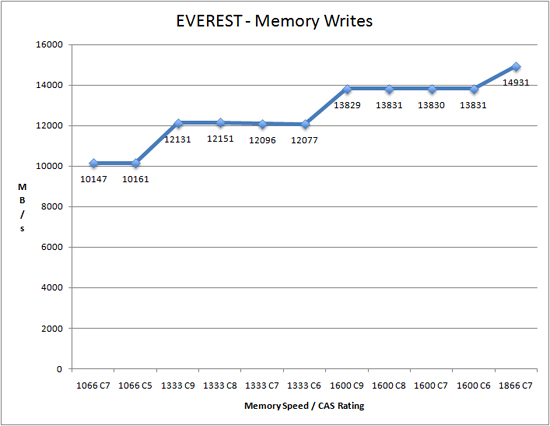
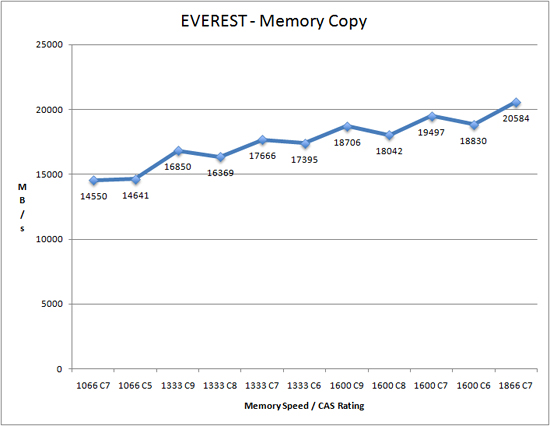
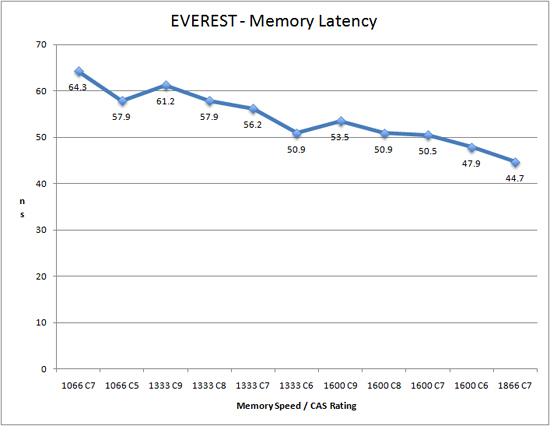
Memory companies love to see these benchmarks in reviews. Of course we enjoy them also as they do give an indication of potential performance improvements in applications, especially the write, copy, and latency results. However, we always temper our expectations with these particular results. Going from 1066 C7 to 1866 C7 nets a 45% improvement in memory reads, 47% in writes, 41% in copy speeds, and 30% in latency. Just remember these results once we get to the application benchmarks.
PCMark Vantage x64
Futuremark's PCMark Vantage x64 is probably the single most diverse set of benchmarks that can be run on a system to mimic real world usage scenarios. We utilized the three test suites out of PCMark Vantage x64 that typically respond well to either memory latency (Memories/Productivity) or bandwidth (TV/Movies) improvement. We run each test three times and average the results.
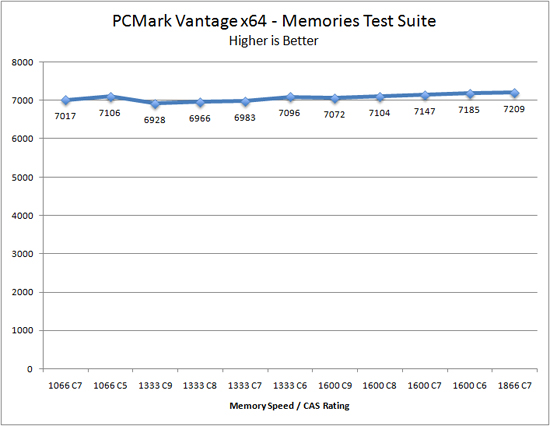
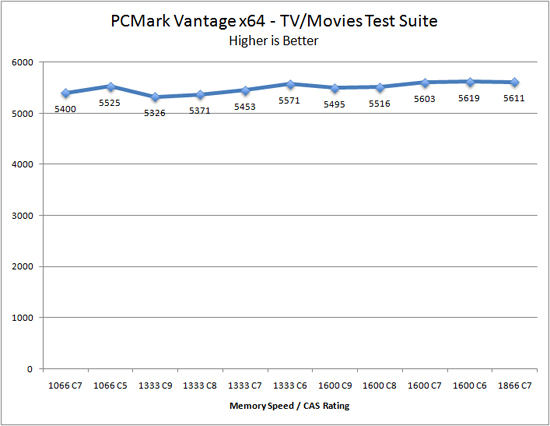
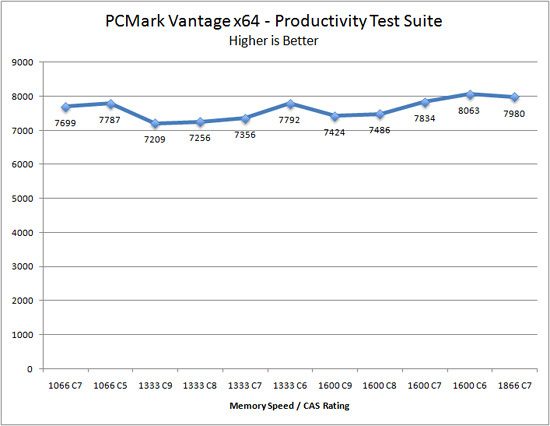
Well that's depressing, there's hardly any performance improvement.
The Memories test suite follows a familiar pattern, as it tends to be sensitive to latency adjustments. We can already see that performance with DDR3-1066 C5 is equal to DDR3-1600 C8. There is a 2% performance improvement moving from 1066 C7 to 1866 C7.
Surprisingly, the TV/Movies test suite responded well to both latency and bandwidth improvements with DDR3-1066 C5 and DDR3-1333 C6 outperforming the other memory speeds until we installed theDDR3-1600 C7 kit. Going from 1066 C7 to 1866 C7 will net almost a 4% improvement in performance, but is something most users will never notice in these applications.
The Productivity test suite has always been sensitive to latency and it shows as we once again see DDR3-1066 C5, DDR3-1333 C6, and DDR3-1600 C6 performing very well in this office application bench. We net a performance increase just over 3% by moving from 1066 C7 to 1866 C7 at stock CPU settings.
















47 Comments
View All Comments
sonci - Thursday, June 25, 2009 - link
The title was enough,and yours is too..
goinginstyle - Wednesday, June 24, 2009 - link
I have no idea where you have been hiding Gary but it is great to see you back. I look forward to the AMD article and the individual module tests. If they are half as good as this, I will be one happy person. Any chance or comments on Virtualization benches under WIn7 with XP?duploxxx - Wednesday, June 24, 2009 - link
very nice article with real world applications, now can you pls do the same with amount of dimms used and finally kill this marketing hype?vailr - Wednesday, June 24, 2009 - link
Re:"Current JDEC specifications list 1.50V as the official voltage specification for DDR3 with a move to 1.35V in the near future and eventually to 1.20V."
How does DDR5 (already being used on some video cards) voltages compare with those numbers?
Any predictions on when DDR5 memory modules for main boards might be introduced?
Are lower latency DDR3 modules "in the works"?
Maybe such a thing as:
1333 MHz @4-4-4-12 & 1.20v, for example?
Also: Intel promotes the benefits of using Hafnium when producing their CPU's. Would Hafnium also benefit memory chips?
GourdFreeMan - Thursday, June 25, 2009 - link
The video cards you are thinking of use GDDR, not DDR. You will never find GDDR packaged on DIMMs for motherboard memory slots, but rather only as individual chips for graphics boards and consoles. Though they share some technologies, you would need a different memory controller to make use of it. Typically GDDR5 runs from 1V to 1.4V (the GDDR5 on the stock Radeon HD 4770 runs at 1.263V for example). Hafnium dioxide has already been used by some manufacturers as the dielectric material in DRAM capacitors, and I know NEC, at least, has already used Hafnium in transistor gates for embedded DRAM. As for higher speed and lower latency RAM, that is pretty much always in the works...Zorlac - Wednesday, June 24, 2009 - link
I have thought this all along, but was too lazy to prove it. Thanks Anand!!! :)Any idea when we will start seeing 4GB DIMMs for running 3x4GB kits?
Gary Key - Wednesday, June 24, 2009 - link
We just finished testing a 12GB 1600 C9 kit from Kingston, but the street price is $1400. I also have a 24GB kit from Corsair, but I will not even mention the cost on that one. We should see affordable (compared to buying 6x2GB) 12GB kits later this year in the 1333 C8 variety without ECC. I do have a 12GB ECC Kingston 1066 C8 kit arriving shortly, retail is about $320, to test in some workstation products.DXRick - Wednesday, June 24, 2009 - link
It looks like the sweet spot is 1600 C8 at around $100 for a 6BG kit.vol7ron - Wednesday, June 24, 2009 - link
agreed --- those saying 1333 really are saving the buckI would still like to see SuperPi tests, since they are a mathematical approach to memory performance.
Gary Key - Wednesday, June 24, 2009 - link
Super Pi results will come in Raja's 2000 shootout. However, most of the Super Pi program runs in cache and when it goes outside of it,it only hits a couple of ranks in short bursts (why bandwidth matters) and as a result a proper loading of the entire memory subsystem is not really tested thoroughly. That said, we will have a complete subsection on Super Pi for the overclocking crowd. :)